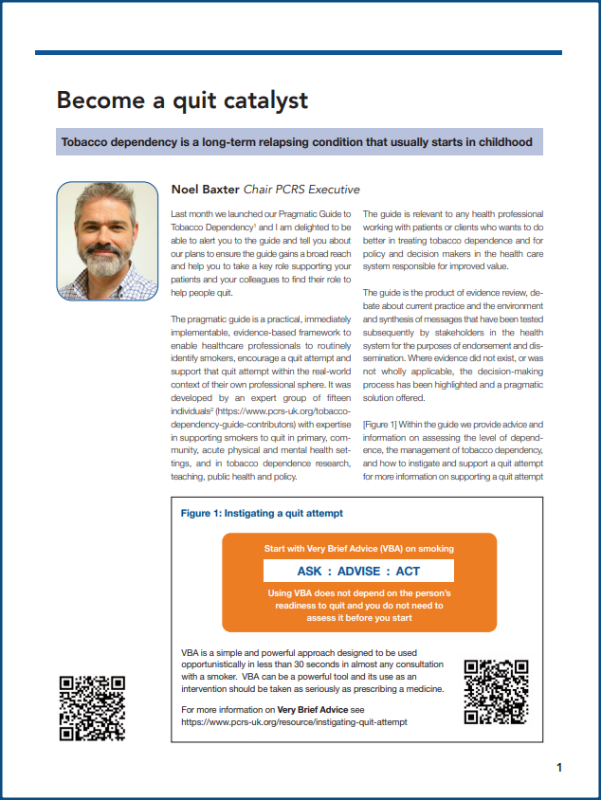

Become a quit catalyst - Very Brief Advice
Very Brief Advice (VBA) is a simple and powerful approach designed to be delivered by any healthcare professional
ASK : ADVISE : ACT
Using VBA does not depend on the person's readiness to quit and you do not need to assess it before you start
Very Brief Advice or VBA is a simple and powerful approach designed to be used opportunistically in less than 30 seconds in almost any consultation with a smoker. VBA is a public health intervention delivered in a one-to-one health setting and can be delivered by any professional. VBA is high value because it is practical, cheap, quick and easy to learn. Delivered correctly, VBA can trigger a quit attempt. Although it is highly unlikely that every delivery will result in a quit attempt, the key to success is repeated, routine delivery of VBA to all patients.
Every VBA should include ASK : ADVISE : ACT even if the act is to simply record your VBA and the outcomes in the medical record so that it is immediately available to the next healthcare professional who encounters the patient. This may make it more likely the next heath care professional, not only uses the VBA approach, but also builds on the previous conversation. The next encounter at which VBA is undertaken may be the one that triggers a quit attempt. It can be delivered by both prescribers and non-prescribers.
The VBA intervention is simple, but its derivation is complex and considered. It condenses significant and robust behavioural research. Language matters and its use as an intervention should be taken as seriously as prescribing a medicine. VBA deliberately does not “challenge the addict” unnecessarily as this may actually reduce the power of the advice.
For example, VBA deliberately does not:
❌ Advise the smoker to stop
❌ Ask if they want to stop
❌ Ask details about what or how much they smoke.
This is because the offer of help in itself can trigger a quit attempt and so responses to such questions are not needed at this stage and should be left to the dedicated stop smoking consultation which will hopefully follow. Providing a positive picture of what this help looks like is also important.
Every conversation with a patient about tobacco use should start with VBA by a health practitioner who has been trained to deliver this conversation. Tobacco VBA is a basic healthcare competency that has to be learned – it is not a chat – it is an evidence-based intervention. Many health practitioners speak with patients about tobacco, but this is not the same as the VBA method and not using an evidence-based approach to this conversation, can potentially prevent rather than encourage a quit attempt.
Clinicians sometimes worry about causing damage to the therapeutic relationship which may prevent raising the issue. Delivering evidence-based tobacco VBA takes away this concern in those who have been trained to deliver it. The question should be adapted for local patterns of tobacco use, for example in communities where smokeless tobacco use is prevalent. It’s important to consider also that smoking is a chronic relapsing condition so even when a patient has stopped smoking there is a risk of starting again. Ex-smokers should be asked about their smoking status until they have stopped for at least three years.
ASK and record smoking status
It is important not just to ask but to record smoking status so that if someone says they are smoking they can be given VBA when they are seen again.
✅ What it is…
- Are you still smoking?
- Do you smoke at all?
- How’s the stopping smoking going?
❌ What it is not…
- Do you want to stop smoking?
- How much do you smoke?
- Why are you still smoking?
- What do you smoke?
ADVISE on how best to stop
The advise part does not involve advising smokers to stop. Instead it is simply advising how best to stop i.e. with behavioural support and medical treatment.
✅ What it is…
- Did you know the most effective way to stop smoking is with a combination of support and medication? Both are available on the NHS, and this combination makes you much more likely to success in quitting.
❌ What it is not…
- You need/have to stop smoking
- If you don’t stop it will kill you!
ACT to signpost best available support and treatment
Your patient does not want to take action…
- OK that’s fine. If you do change your mind at any time don’t forget we are always ready to help you quit.
Your patient does want to take action…
- That’s great news! All you need to do is book an appointment and we can give you all the treatment and support you need to help you quit.
The act part is to direct the smoker to the best available support and treatment to help them quit. Ideally this would be from a stop smoking service or trained stop smoking advisor. If this is not available locally you can recommend that they make a dedicated appointment with yourself or an appropriate member of the practice team. You or they can then go through treatment options provide prescriptions and help support them with a few appointments while they quit.
The above describes basic VBA which is designed for opportunistic delivery to any smoker in less than 30 seconds during any clinical encounter. This in the minimum which should be delivered as part of routine practice. Depending on the patient, time available and clinical circumstances, VBA can be modified and extended as necessary to improve the chance of the smoker engaging in a supported quit attempt.

Tobacco dependency pragmatic guide
Tobacco dependency is a long-term relapsing condition that usually starts in childhood
Our tobacco dependency pragmatic guide is a practical, immediately implementable, evidence-based framework to enable healthcare professionals to routinely identify smokers, encourage a quit attempt and support that quit attempt within the real-world context of their own professional sphere.
Andy McEwenIf you have an understanding of tobacco dependence, then compassion follows, and you are not judgemental
Chief Executive, National Centre for Smoking Cessation and Training, 2018
You may also be interested in...
The use of nicotine containing e-cigarettes as a smoking cessation aid
E-cigarettes have become increasingly popular in recent years. The main reason given by current vapers for using e-cigarettes is to help them stop smoking tobacco. This pragmatic article provides information on the safety and effectiveness of e-cigarettes as a stop smoking tool.
Key Knowledge, Skills and Training for Clinicians Providing Respiratory Care
The UK's leading respiratory conference for clinicians working primary, community and integrated care comes to Telford in September.